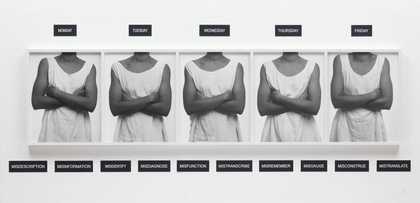Explore the pervasive power of images in contemporary life and mass media
In the early 1980s, American artist Barbara Kruger began working in her signature graphic style combining photographic imagery with bold text. Her work engages with identity politics and criticises the spectacle of mass-media imagery while adopting its visual language as a powerful means of communication. Ironically, Kruger's style was itself appropriated by clothing brand Supreme for their logo. Commenting on this, she said 'I make my work about this kind of sadly foolish farce.'
This room presents works including paintings and photography-based art to explore the relationship between identity and mass media. Kruger's ninepanel work resembles a teaching-aid, using sign language and words to speak of the opposition between gender roles. Hito Steyerl similarly adopts the tone of a formal instructional presentation, suggesting ironic ways in which we might prevent ourselves from being captured visually by digital technology.
Lorna Simpson's series of captioned photographs are a form of anti-portraiture, presenting a cropped image of a subject as a de-individualised representative of a wider group. Constructed media identities are also exposed in the work of VALIE EXPORT, who in the late 1960s created an artistic persona to comment on gender roles in society. In a similar vein, pop artist Billy Apple exposes tension between reality and the strategies adopted when formulating a publicfacing identity. The American artist Robert Heinecken sought to extend the possibilities of the photographic medium. His altered magazines examine the manufacture of daily life by mass media and the relationship between the original and the copy, both in art and society at large.
Tate Liverpool + RIBA North

